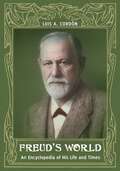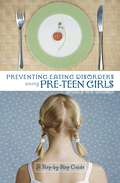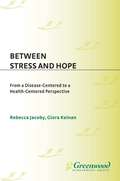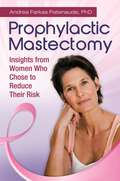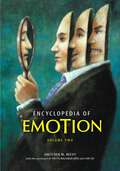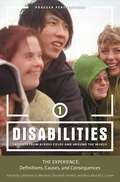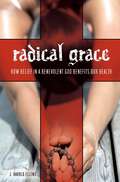- Table View
- List View
Freud's World: An Encyclopedia of His Life and Times
by Luis A. CordónComprising well-known and obscure information, this compendium provides a historical context to the facts of Sigmund Freud's life, theories, and influence on society.Sigmund Freud is one of the most influential 20th-century intellectuals in Europe and the United States. His innovative theories and unprecedented practices are topics worthy of extensive review, but just as fascinating are the events of his life and the origins of his core beliefs.Freud's World: An Encyclopedia of His Life and Times organizes the important components of Freud's life and work in an encyclopedia format, enabling readers to quickly zero in on the particular ideas, individuals, and circumstances that contributed to his vast influence. Controversy about the scientific utility of psychoanalytic concepts is specifically addressed. Gathering a wide range of information into a single, easy-to-read volume, this book serves as an ideal starting point for any student interested in learning about Sigmund Freud.
Defending and Parenting Children Who Learn Differently: Lessons from Edison's Mother (The Praeger Series on Contemporary Health and Living)
by Scott TeelTeel incorporates the fascinating story of Nancy Edison's love for her son Thomas, who had been labeled unteachable, then presents us with the wider array of and issues for children who learn differently.We all know Thomas Edison was a genius of seemingly limitless imagination. Yet few know he was a failure in elementary school. Teel shows us how Edison's mother, Nancy, guided the boy deemed a dunce by officials—even assumed mentally retarded by his father—to become one of the greatest inventors of all time. Edison's progressive and imaginative teaching methods hold lessons even today for all children who learn differently from conventional methods, as well as for the parents and teachers who care about them. Teel also explains how parents can negotiate the educational maze created by the Individuals with Disabilities Education Act (IDEA) and the No Child Left Behind Act (NCLB). An Individualized Education Program is explained in detail, and options such as enlisting the assistance of a professional advocate are also discussed.The latest research about current medication therapies and the origins plus potential benefits of ADHD are reviewed. A leading professional advocate explains what every parent needs to know about the public school system. Other topics addressed include the effectiveness of home schooling and parental and student rights. An extensive list of local and national resources is also offered.
Preventing Eating Disorders among Pre-Teen Girls: A Step-by-Step Guide (Non-ser.)
by Beverly MenassaA must for parents, teachers and counselors, this book targets preadolescent girls aiming to engage them in educational activites that will empower them to avoid eating disorders. The author examines eating disorders from sociocultural and feminist perspectives showing how disorders are most often caused by overexposure to media messages, an unrealistic cultural fascination with thinness, by continuous anaylsis of our bodies and a disordered cultural view of food. Then Menassa presents a 10-session guide to prevention that engages girls in activities to spur and empower their independent thinking and reasoning. For example, girls become watchdogs of the media and write to companies that present women in a negative light in their advertisements. The girls challenge ingrained beliefs and replace them with healthier ones.Preadolescence is a time when girls' minds are malleable and they are willing to challenge established activities, such as media presentations. Once girls hit puberty, many will have already developed disordered eating behaviors; many will have been on several diets; therefore, beginning the work to decode and combat harmful messages before that stage is crucial.
Sudden Influence: How Spontaneous Events Shape Our Lives
by Michael A. RousellAll of us, writes psychologist Michael Rousell, are subject to Spontaneous Influence Events, (SIEs), when seemingly minor moments have truly life-changing effects. Rousell, who has studied such events across decades, shows us how SIEs—which occur when we are emotionally charged—trigger an intense response and activate a mental state of extreme suggestibility. He explains how SIEs disarm our instinctive defense mechanisms and rational thinking processes, leaving us open to instant adoption of new beliefs. In this unique book, he looks at the neurobiology of this spontaneous change. He details how we can recognize Elevated Suggestibility States or teachable moments, then use that knowledge to create positive SIEs for ourselves and those we love. And he explains how we can undo the damage of negative SIEs that may be haunting us, holding us back, or hurting us.Songwriter Carly Simon recalls an emotionally intense high school episode when her boyfriend referred to her stammer as charming. Simon regards that moment as a turning point for her self-esteem, and so her future. Other celebrities share similar, seemingly minor moments with truly life-changing effects. Tennis champion Venus Williams recalls one of her sister's pep talks when her words changed my life. Basketball star Shaquille O'Neal credits an offhand remark by his mother as the words that changed everything for me. All three cases illustrate a Spontaneous Influence Event, or SIE. In this book, psychologist Michael Rousell, who has studied such events across decades, shows us how SIEs—which occur when we are emotionally charged—do occur for most of us, for better or worse. These events trigger an intense emotional response and activate a mental state of extreme suggestibility. There is thus fertile ground for statements about our worth, abilities, and potential to be implanted solidly in our minds, leading to success or failure, often without our completely comprehending the effect and why it occurred.Rousell explains how the sudden impact of these SIEs disarms our instinctive defense mechanisms and rational thinking processes, leaving us open to instant adoption of new beliefs. In this unique book, he looks at the neurobiology of this spontaneous change, why the events occur, how to defend against the negative among them, and how to manage or promote positive SIEs. He also explains, through common vignettes, how and why the brain encodes SIEs to be triggered again and again in memory at later dates. Finally, Rousell details how we can recognize Elevated Suggestibility States or teachable moments, then use that knowledge to create positive SIEs for ourselves and those we love. And he explains how we can undo the damage of negative SIEs that may be haunting us, holding us back, or hurting us.
Forensic Science: Modern Methods of Solving Crime
by Max M. HouckFrom Poe's Dupin and Doyle's Holmes to the television hits Quincy and CSI, the public's fascination with science employed to solve crimes continues and grows. But this understanding of how science works in the forensic laboratory is filtered through the fictional worlds of books and television-how is science really used to fight crime? What techniques are used to catch criminals and free the innocent? Forensic scientists work with police, investigators, medical personnel, attorneys, and others to uphold justice, but their methods are often misunderstood, overestimated, underestimated, revered, or disputed. Here, the author answers many common questions about forensic science: How is the science conducted and by whom? What are the real limits, and real benefits, of forensic science? What new techniques are emerging to catch 21st Century criminals? Readers are treated to an insider's overview of the realties of forensic science.Forensic Science: Modern Methods of Solving Crime covers the basic concepts of forensic science and how it assists in criminal investigations. Starting with a brief history of forensic science, from its early days in Europe to the modern advances of today, the book describes each method and presents cases that highlight the applications of the methods. Houck profiles pioneers in forensic science, offers an overview of such forensic topics as DNA, fibers, fingerprints, and firearms, takes readers through the collection and processing of evidence, and uses frequent examples and anecdotes to illustrate all the major areas of forensic science. This introduction to the field is a useful starting point for anyone wishing to learn more about the real world of forensic science.
Resilience: Learning from People with Disabilities and the Turning Points in Their Lives (Praeger Series in Health Psychology)
by Gillian King Elizabeth G. Brown Linda K. SmithThis volume brings to life the nature of resilience and adaptation to change by describing turning points, or critical experiences, in the lives of people with disabilities. People with cerebral palsy, spina bifida, or attention deficit disorder are interviewed. They describe events and experiences that changed their lives and pinpoint which factors helped or hindered their adaptation. Interweaving these compelling stories with popular thought and research evidence, the authors show how understanding the resilience of people with disabilities may help all readers create meaning in life and become resilient.Rich in personal detail, yet strong in its presentation of academic literature and other non-fiction works related to resilience, this volume will appeal to a wide variety of readers, from people who wonder about the meaning of life, to the parents of children with disabilities and organizations that deliver services to them, to students and professors in the fields of psychology, education, social work and occupational therapy.
Not All Twins Are Alike: Psychological Profiles of Twinship (Non-ser.)
by Barbara KleinEven twins are unique. Most people idealize twins, fantasizing a close, perpetually loving relationship. Yet Klein, herself an identical twin, demonstrates that twins have complicated and intense relationships that range from over-identification or excessive closeness to profound estrangement and conflict. Most twins who are raised as individuals deal with the significant emotional pain of separation in adolescence or young adulthood, yet as mature adults can come to love and respect each other as individuals.As Klein makes clear, the parenting that twins receive as infants and young children affects the relationships that they have with one another and with the world they choose to function in. Because parenting is a critical determinant of psychological well-being, it should be treated as a serious but manageable challenge. This book is a must-read for twins, their parents, and scholars, students, and other researchers and professionals dealing with mental health and child development.
Between Stress and Hope: From a Disease-Centered to a Health-Centered Perspective (Praeger Series in Health Psychology)
by Rebecca Jacoby Giora KeinanThis volume focuses on the concepts of stress and hope, their psychological and physical outcomes. Past research has focused primarily or exclusively on either stress or hope and its effect on health. This work discusses them side by side and highlights their interrelations. Various theoretical approaches dealing with stress and hope are discussed, and a review of the most recent empirical data is presented. Also included are reports on individuals and groups that have been exposed to various stressful situations, such as racial prejudice, life threatening illness, or imprisonment. The role of hope in coping with these sitatuions is emphasized.Contributors to this edited collection are at the cutting edge of theory and research in the fields of stress and hope. Students and scholars studying health psychology, stress management or stress and coping will appreciate the information presented, as will those involved with medical science, nursing, and sociology.
Interprofessional Practice with Diverse Populations: Cases in Point (Non-ser.)
by Allan Barsky Esther Geva Fern WesternoffConcepts such as cultural competence, multicultural practice, and ethnosensitivity have taken root in the literature. At the same time, concepts such as cross-disciplinary, transdisciplinary, interdisciplinary, and interprofessional practice have been articulated. Although these two trends coexist in print, the literature in the various helping professions does not address whether and how the issues of client diversity and interprofessional practice can come together in productive and better informed ways. The present book promises to close this gap and offer health care professionals theoretically grounded examples of best practices. The range of diversity includes Native American, Taiwanese, Portuguese, African-American, Algerian, Irish, South Asian, and gay clients.
The Torture and Prisoner Abuse Debate (Historical Guides to Controversial Issues in America)
by Laura L. FinleyRevelations about U.S. torture and prisoner abuse in blatant violation of the long-established and universally recognized Geneva Conventions have horrified most Americans. Nevertheless, it has been argued that the high stakes of the War on Terror have made the protections offered by the Conventions obsolete, or that the abuses are the work of a few rogue soldiers and officers. This book reaches past the headlines into the historical record to document POW torture and also domestic prisoner abuse dating well back in our history as well as government and military knowledge of and collusion in such ostensibly illegal and reprehensible acts. Is torture and prisoner abuse justified in the name of some greater good? As a society we shall have to decide. The historical record presented here can contribute much to an informed national discussion.
ADHD (Biographies of Disease)
by Paul Graves HammernessDiseases have a history, and understanding that history helps us understand how best to treat and control disease today. Today's students are confronted with a panoply of often-frightening illnesses and afflictions - the Biographies of Disease series provides students with the information that they need to understand the origin of various maladies, how they impact contemporary society, and how doctors and researchers from around the world are fighting to devise treatments to alleviate or cure these diseases. This volume, ADHD, examines Attention Deficit Hyperactivity Disorder, the controversial affliction with which millions of boys and girls are diagnosed every year.
How Globalization Spurs Terrorism: The Lopsided Benefits of One World and Why That Fuels Violence (Praeger Security International)
by Fathali M. MoghaddamThis book explores modern Islamic terrorism in the context of globalization and cultural evolution. 21st century terrorism is different and new, first because it relies heavily on electronic communication systems and other aspects of modern technologies, and second, because it is in large part a product of fractured globalization, with its associated threats to the collective identity of Muslims. Part one of this work contrasts globalization as an ideal with globalization as it is actually taking place, with its enormous contradictions and threats. Moghaddam, a longtime and highly respected terrorism and conflict researcher, argues that globalization is resulting in serious threats to the basic psychological needs of some, particularly in connection with collective identity. Part two explores how globalization has brought sudden contact between different groups with no previous history of large-scale contact, resulting in a rapid decline in diversity. Terrorism is one of the dysfunctional defense mechanisms of people in such conditions, facing external threats. Part three describes long-term solutions, focusing particularly on the role of women and the nature of the family in traditional Islamic societies.Moghaddam shows us why globalization is resulting in what he calls catastrophic evolution, the rapid decline and disappearance of minority cultures and languages, and why that brings a clash of ideologies and the rise of extremism. There are also other dangerous trends, and those call for inspired solutions, springing from an understanding that traditional conflict-resolution, evolved in the shadow of the Cold War, is no longer effective and needs to change.
An Intimate Understanding of America's Teenagers: Shaking Hands with Aliens
by Bruce J. GevirtzmanAlicia is so obsessed with being popular, she does things that would shock her parents, if they knew. Hector is aware the gang that wants him to join may be the death of him, but he will not decline. Sam was a baseball star, but can't play the sport he loves anymore because he is wracked from football injuries, a sport his father will not let him quit. They are just a few of the teenagers that readers will meet, in this candid book authored by a 34-year veteran high school teacher. Voted Teacher of the Year and Coach of the Year, Bruce Gevirtzman shares with us the results of his years spent talking with teenagers about topics from life and lust to depression and death. Revealing honest, poignant words shared in conversations, classroom talk, interviews, surveys, and journals, Gevirtzman takes us inside the minds of today's youths, and also contrasts them with teenagers of decades past. Topics include teen thinking and secrets on issues from sex, drinking, and drugs to peer pressure, self-imposed standards, and beliefs about what is important, and painful, in life.Including interviews with fellow teachers, Gevirtzman's book is threaded with one recurring truth: Sadly, instead of parents and teachers and lawmakers and the public looking out for our kids, today's kids are largely left to fend for themselves, he concludes. Not only will general readers and educators find great insight in this work, it will be of interest to students and scholars of adolescent psychology, clinical psychology, and social work.
Prophylactic Mastectomy: Insights from Women Who Chose to Reduce Their Risk
by Andrea PatenaudeThis book presents the candid stories of women at high hereditary risk of breast cancer who chose to have their breasts surgically removed while they were still healthy, rather than risk getting the cancer that had, in many cases, devastated others in their family.Author Andrea Farkas Patenaude, a clinical psychologist at the Dana-Farber Cancer Institute, has spent much time talking with women who decided to have risk-reducing or prophylactic mastectomy rather than undergo a lifetime of repeated screenings—a strategy that can help to detect cancers early, but cannot prevent breast cancer. In Prophylactic Mastectomy: Insights from Women Who Chose to Reduce Their Risk, Patenaude shares many candid stories from these women and documents the risks and benefits of this decision.The potential emotional trauma and lifelong effects on self-concept, body image, and sexual function for those who choose the surgery are profound. While the risks involved are great, these interviews also demonstrate the relief many women find in making this powerful decision. This book supplies much-needed guidance for both patients and physicians in confronting this complex decision, and provides comprehensive information on how women fare emotionally and interpersonally after this life-altering surgery.Interviewed as part of a study funded by the Department of Defense Breast Cancer Research Program and the National Human Genome Research Institute, the subjects are diverse: married and single women, young adults, the middle-aged, parents, and women without children. Every case reveals the ramifications of each individual's difficult but potentially life-saving decision. The women explain why they made their choice, how they adapted to the new look of their bodies, and how they cope with spouses', partners', and family members' reactions to their changed physique.
A Hallucinogenic Tea, Laced with Controversy: Ayahuasca in the Amazon and the United States
by Marlene Dobkin Rios Roger RumrrillOne country's sacrament is another's illicit drug, as officials in South America and the United States are well aware. For centuries, a hallucinogenic tea made from a giant vine native to the Amazonian rainforest has been taken as a religious sacrament across several cultures in South America. Many spiritual leaders, shamans, and their followers consider the tea and its main component - ayahuasca - to be both enlightening and healing. In fact, ayahuasca (pronounced a-ja-was-ka) loosely translated means spirit vine. In this book, de Rios and Rumrrill take us inside the history and realm of, as well as the raging arguments about, the substance that seems a sacrament to some and a scourge to others. Their book includes text from the United Nations Convention on Psychotropic Substances and interviews with shamans in the Amazon.One country's sacrament is another's illicit drug, as officials in South America and the United States are well aware. For centuries, a hallucinogenic tea made from a giant vine native to the Amazonian rainforest has been taken as a religious sacrament across several cultures in South America. Many spiritual leaders, shamans, and their followers consider the tea and its main component - ayahuasca - to be both enlightening and healing. In fact, ayahuasca (pronounced a-ja-was-ka) loosely translated means spirit vine. Ayahuasca has moved into the United States, causing legal battles in the Supreme Court and rulings from the United Nations. Some U.S. church groups are using the hallucinogen in their ceremonies and have fought for government approval to do so. The sacrament has also drawn American drug tourists to South America to partake, say authors de Rios and Rumrrill. But they warn that these tourists are being put at risk by charlatans who are not true shamans or religious figures, just profiteers.In this book, de Rios and Rumrrill take us inside the history and realm of, as well as the raging arguments about, the substance that seems a sacrament to some and a scourge to others. Opponents fight its use even as U.S. scientists and psychologists continue investigations of whether ayahuasca has healing properties that might be put to conventional use for physical and mental health. This book includes text from the United Nations Convention on Psychotropic Substances and interviews with shamans in the Amazon.
Encyclopedia of Emotion [2 volumes]: [2 volumes]
by Gretchen M. ReevyThis unique two-volume reference is an accessible, up-to-date resource for the rich and fascinating study of human emotion.Drawing on both contemporary and classic research, Encyclopedia of Emotion explores the complex realities of our emotional lives and communicates what psychologists have learned about them to date in a clear and captivating way. The landmark work bridges the divide within psychology as a discipline between basic and applied science, gathering together in one comprehensive resource both theoretical and clinical perspectives on this important subject. In two volumes, Encyclopedia of Emotion offers more than 400 alphabetically organized entries on a broad range of topics, including the neurological foundations of emotional function, competing theories of emotion, multicultural perspectives on emotions, emotional disorders, their diagnosis and treatment, and profiles of important organizations and key figures who have shaped our understanding of how and why we feel the way we do.
Adult Children of Divorce: Confused Love Seekers (Non-ser.)
by Geraldine K. PiorkowskiRomantic love is often an elusive, fragile, and tenuous state, difficult to maintain across time. The rates of divorce, re-divorce, relationship violence, and abuse today attest to the face we are failing at romantic love. And for teen-aged and adult children of divorce, romantic love can be especially elusive. Because they have no roadmap for a satisfying, stable romatic relationship derived from their own parents, they are confused by what love is and tend to make poor partner choices. Borrowing heavily from popular culture for unrealistic standards regarding love, they become disillusioned when their all-too-ordinary lovers don't measure up. Especially vulnerable to the problems their parents had, they tend to overreact in a similar negative fashion and are all too ready to consider divorce when unhappiness strikes. In attempting to halt intergenerational transmission of divorce, Psychologist Piorkowski points to how we can recognize that American popular culture presents an overly-sexualized, explosive, and superficial version of love that can't last. With this book, adult children of divorce can begin to see how they have been affected by familial experiences, and develop a new, realistic map to find more fulfilling and enduring romantic relastionships.Piorkowski, in an extensive review of literature, also looks at cultural factors and how they impact romantic love and marriage. In contrast to American popular culture's shallow rendition of romantic love, many cultures elsewhere in the world emphasize compatibility, religion, and family allegiance. As a result, says the author, such marriages appear more stable than American unions built upon the shifting sands of emotion.
Disabilities [3 volumes]: Insights from across Fields and around the World [3 volumes]
In this three-volume set, experts from around the world spotlight the latest research on physical and psychological disabilities, as well as the social, legal, and political issues that come to bear on those people affected. These authors teach us what the disabilities are, how common they have become, what challenges people with disabilities face, what treatments are available, and whether new promising efforts for rehabilitation are on the horizon.We also learn, in these volumes, about social actions that have advanced human rights for people with disabilities in countries around the world. Yet, we learn that in these same countries, discriminatory actions against people with disabilities continue to occur. The impact of different cultural beliefs about disability are explored and these beliefs are juxtaposed against legislative responses. In all three volumes, people with disabilities share their personal narratives about events they have faced in society. They provide rich examples of how culture, social interactions, and legislation can impact on people.
Coping with Vision Loss: Understanding the Psychological, Social, and Spiritual Effects
by Cheri Colby Langdell Tim LangdellThis book explains in detail what it is like to be losing sight, legally blind, or fully blind, and also documents why today's exciting technological advances and medical solutions are lifting limitations for the visually impaired.Dr. Cheri Langdell, a professor of English, and Dr. Tim Langdell, a clinical psychologist and digital media expert, take us through personal, psychological, sociological, and cultural perspectives on blindness, and—perhaps surprisingly—show us some of the benefits nearly blind and blind people have found after vision loss. These benefits include what some describe as heightening of the other senses, deepening spiritual sight, and stronger insights into the human condition. Through literature, media, and cinema across the ages, the authors focus attention on how the masses worldwide who are sighted view, and treat, the blind and legally blind. Coping with Vision Loss: Understanding the Psychological, Social, and Spiritual Effects also includes non-fiction written about and by the blind that gives great insight into their condition. The text explains what the visually impaired and blind can do to stay strong and live their lives to the fullest, as well as what family members and friends can do to help when needed, or to back off when one wants to be as independent as possible. Technological advances to assist the blind and legally blind are reviewed, as are websites for a host of organizations created to assist people with vision loss.
Mothers-in-Law and Daughters-in-Law: Understanding the Relationship and What Makes Them Friends or Foe
by Deborah M. MerrillWe all know - have perhaps told a few - stories about mothers-in-law and daughters-in-law. It seems the stories are nearly always about relationships filled with conflict and abrasive words or actions. But why is this relationship so difficult? And is it always as bad as popular belief would have us think? Deborah Merrill, a woman's advocate and Sociology professor at one of our nation's top universities, has been studying the relationship for nearly a decade and, in this book, explains where the difficulty is rooted, how friendly pairs have made it past problems that surface between a man's mother and his wife, and how they became friends. Dozens of interviews with pairs of women made in-laws by marriage illustrate Merrill's points, from harmful ideas and actions to helpful approaches. At its core, this book holds that marriage requires the creation of a new and separate family, which requires changes in roles, as well as a redefinition of relationships. Hence, family boundaries need to be made permeable to allow for integration of the daughter-in-law, and to allow the son to create his own separate and autonomous family. Family members need to be aware of, and prepare for, this, says Merrill. That, of course, may be easier said than done. But dozens of women who have become friends with their in-laws — some so much so that they drop the in-law and just call each other mother and daughter — explain how they got past the old, popular notions and social structure, to create goodwill and grow stronger families.
The Serpent and the Dove: Celibacy in Literature and Life (Psychology, Religion, and Spirituality)
by A. W. SipeRichard Sipe, himself a former monk and priest, has made a lifelong venture of determining the reality and meaning of religious celibacy. Even an adequate operational definition of religious celibacy, he says, has been avoided by Catholic hierarchy and scholars to preserve the celibate myth. Having spent 25 years conducting a study of celibacy and sexual behavior in Roman Catholic priests, Sipe concluded that at any one time no more than 50 percent of priests were practicing celibacy. To more fully understand what celibacy is, how it is practiced, the affect it has on the humanness of men of women, and the social effects it presents, Sipe says we can use the approach presented in this book. Specifically, we can analyze historic men who presented themselves or were perceived as living examples of celibacy and also focus on the most profound truths of celibacy found in literary accounts.Psychology, religion, and literary criticism interface and are woven together in this book with minimal jargon. The Serpent and the Dove was written in the hope of exciting honest analysis of the essence of religious celibacy and to foster a recrudescence of authentic sexual vigor with all of its evolutionary potential. Human sexuality is not going away; nor is it irrelevant to the wellbeing, progress and happiness of the human community, says Sipe. And the practice of genuine celibacy is not going to disappear either. No question, the Catholic Church needs profound reformation. But in all my work I have chosen not to throw any babies out with the horrendously dirty 'holy water' the church continues to treasure and disseminate. Here, as in all my work, I try to foster dialogue between religion and science, such as literary criticism. The Catholic Church (and religion) is at a Copernican Moment when it has to cede to science the nature of sexuality. The Serpent and the Dove is one more work among Sipe's many books and articles making the need for that clear.
Encyclopedia of Addictions [2 volumes]: [2 volumes]
This two volume set contains frank and factual information about symptoms, causes, effects, prevention, and treatment of substance abuse—alcohol, nicotine, and drugs—and of behavioral addictions such as eating disorders, pathological gambling, and compulsive sexual activity. Including the most up-to-date research, the addiction entries are based largely on criteria established by the American Psychiatric Association in its Diagnostic and Statistical Manual of Mental Disorders.Tracing the history of the debate over whether addiction is a choice or a disease, the volumes explain how genetic and biological findings support the disease concept while lifestyle choices affect the course of the disease. Graphics and discussions of the brain structures that support this self-reinforcing mechanism illustrate why treatments that obstruct the pathway are showing such promise.
Autism (Biographies of Disease)
by Lisa D. BenaronFew issues cause as much strife in contemporary society as does the cause and treatment of autism. Stories about the autism epidemic abound on talk shows and make headlines in newspapers and magazines. Celebrities and politicians express their personal opinions on the cause (or causes) of the increase in autism spectrum disorders (or ASDs), opinions often not shared by the conventional scientific community. Parents, family members, schools and government-funded agencies struggle to do the right thing for individuals with ASDs, This volume in the Biographies of Disease series provides an understandable, non-biased guide to the quagmire of information about ASDs. This foundation will enable readers to better understand the statements made by various authorities on ASDs. Autism covers all aspects of our historical and current understanding of autism spectrum disorders. The text starts with the recognition of autism in the forties and traces the development of ways to diagnose autism, explains why autism has been expanded to the autistic spectrum disorders. The author covers what is known and not known about the autism epidemic and the causes of ASDs. The critical importance of screening and early intervention is emphasized with respect to outcome for individuals with ASDs. Promising areas of research are highlighted. After reading this book, the reader will be able to place the latest breaking news about ASDs into perspective. While it is not yet possible to answer all of the questions about autism, this book allows the reader to follow along as the mystery is unraveled.Autism covers all aspects of our historical and current understanding of autism spectrum disorders: The recognition of autism in the forties and the development of ways to diagnose autism; why autism has been expanded to the autistic spectrum disorders; what is known and not known about the autism epidemic and the causes of ASDs; the importance of screening and early intervention as well as information about outcome for individuals with ASDs; and promising areas of research.After reading this book, the reader will be able to place the latest breaking news about ASDs into perspective. While it is not yet possible to answer all of the questions about autism, this book allows the reader to follow along as the mystery is unraveled.
Radical Grace: How Belief in a Benevolent God Benefits Our Health (Psychology, Religion, and Spirituality)
by J. Harold EllensThe esteemed editor who brought us the acclaimed set The Destructive Power of Religion, turns his attention here to a similarly powerful, yet positive side of religion: how our concept of God can fuel healthy body and mind. This book contends that all health—mental and physical—is shaped, for good or ill, by our spiritual, theological, and psychological notions about the nature of God, and by the way we form an outlook on life as a result of these notions. Across history, a large percentage of people have believed that God is a threat, an attitude Ellens describes as sick gods created through pathological beliefs, or sick gods that make sick people. But Ellens grounds his brighter perspective in this text on God as a source of unconditional grace and goodwill, then illuminates the effect this perspective has on people who have incorporated it into their minds and lives.Ellens shows that people with firm faith in God's radical grace are psychologically strong and healthy. His offering of psychology interfacing with theology is reminiscent of Carl Rogers' teaching on unconditional positive regard and its ability to heal suffering persons. All readers, he explains, can benefit by this understanding that can inspire spiritual and psychological healing whether for ourselves, family, friends, or clients in counseling or therapy.
The Inner World of a Suicidal Youth: What Every Parent and Health Professional Should Know
by Mildred Osborne M.D.Electra is a well-loved, beautiful, highly intelligent teenager. Yet, as is not uncommon, she becomes so depressed she contemplates suicide, considering it for years until she finally takes action. Electra's diary, discovered after her death and presented here by a psychiatrist, reveals her first-person reflections through to her fatal college year, showing how thought distortions are caused and how they chip away at self-esteem and the will to survive. In addition to enlightening professionals and aspiring professionals, this work will empower parents to identify and address growing dimensions in their children's development, and understand the struggles they face. And the end result is that Electra's diary teaches us all a lot about changes that are needed so that we can develop effective suicide prevention and treatment strategies, says author Millie Osborne, M.D.Suicide is now a public health crisis. It is the third leading cause of death for youths aged 15 to 24, and the fourth leading cause of death for children aged 10 to 14. As author Osborne explains, Existing approaches to preventing youth suicide have had little impact on reducing the number of suicides and suicide attempts across America. By unveiling the private thoughts of a suicidal teenager in this unprecedented book, Osborne hopes that the legacy of Electra will be an understanding of the adolescent mind that will spur more effective means to recognize, treat, and heal those at risk, and so vastly reduce suicide among our youths.
